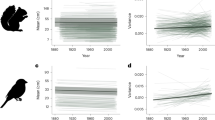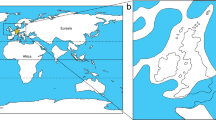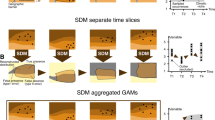Abstract
About 70% of North American large mammal species were lost at the end of the Pleistocene epoch1. The causes of this extinction—the role of humans versus that of climate—have been the focus of much controversy1,2,3,4,5,6. Horses have figured centrally in that debate, because equid species dominated North American late Pleistocene faunas in terms of abundance, geographical distribution, and species variety, yet none survived into the Holocene epoch. The timing of these equid regional extinctions and accompanying evolutionary changes are poorly known. In an attempt to document better the decline and demise of two Alaskan Pleistocene equids, I selected a large number of fossils from the latest Pleistocene for radiocarbon dating. Here I show that horses underwent a rapid decline in body size before extinction, and I propose that the size decline and subsequent regional extinction at 12,500 radiocarbon years before present are best attributed to a coincident climatic/vegetational shift. The present data do not support human overkill1 and several other proposed extinction causes2,3, and also show that large mammal species responded somewhat individualistically to climate changes4,5,6 at the end of the Pleistocene.
This is a preview of subscription content, access via your institution
Access options
Subscribe to this journal
Receive 51 print issues and online access
$199.00 per year
only $3.90 per issue
Buy this article
- Purchase on Springer Link
- Instant access to full article PDF
Prices may be subject to local taxes which are calculated during checkout



Similar content being viewed by others
References
Martin, P. S. in Quaternary Extinctions (eds Martin, P. S. & Klein, R. G.) 345–403 (Univ. Arizona Press, Tucson, 1984)
Zimov, S. A. et al. Steppe–tundra transition: A herbivore driven biome shift at the end of the Pleistocene. Am. Nat. 146, 765–794 (1995)
MacPhee, R. D. E. & Marx, P. A. in Natural Change and Human Impact in Madagascar (eds Goodman, S. M. & Patterson, B. D.) 169–217 (Smithsonian Institution Press, Washington, 1997)
Guthrie, R. D. in Megafauna and Man (eds Agenbroad, L. D., Mead, J. I. & Nelson, L. W.) 42–54 (The Mammoth Hot Springs Scientific Papers, Vol. 1, North Dakota, 1984)
Graham, R. W. & Lundelius, E. L. Jr in Quaternary Extinctions (eds Martin, P. S. & Klein, R. G.) 223–250 (Univ. Arizona Press, Tucson, 1984)
Guthrie, R. D. in Quaternary Extinctions (eds Martin, P. S. & Klein, R. G.) 259–298 (Univ. Arizona Press, Tucson, 1984)
Eisenmann, V. & Karchoud, A. Analyses multidimensionelles de métapodes d'Equus sensu lato (Mammalia, Perissodactyla). Bull. Mus. Natl Hist. Nat. Paris Ser. 4, 75–103 (1982)
Forsten, A. Equus lambei the Yukon Canada wild horse not ass. J. Mamm. 67, 422–423 (1982)
Vilà, C. et al. Widespread origins of domestic horse lineages. Science 291, 474–477 (2001)
Harington, C. R. Annotated Bibliography of Quaternary Vertebrates of Northern North America (Univ. Toronto Press, Toronto, 2003)
Matheus, P., Kunz, M. & Guthrie, R. D. in Abstr 3rd Int. Mammoth Conf. 3–5 (Yukon Territorial Government, Dawson, Canada, 2003)
Forsten, A. Size decrease in Pleistocene–Holocene true or caballoid horses in Europe. Mammalia 55, 407–420 (1991)
Guthrie, R. D. in People and Wildlife in Northern North America (eds Gerlach, C. & Murray, M.) 32–49 (Br. Archaeol. Rep., Int. Ser. 944, 2001)
Guthrie, R. D. Frozen Fauna of the Mammoth Steppe (Univ. Chicago Press, Chicago, 1990)
Guthrie, R. D. Variability in characters undergoing rapid evolution, an analysis of Microtus molars. Evolution 19, 214–233 (1965)
Guthrie, R. D. in Contributions in Vertebrate Paleontology (eds Genoways, H. H. & Dawson, M. R.) 482–510 (Carnegie Museum of Natural History Special Publication 8, Pittsburgh, 1964)
Wilson, M. C. Late Quaternary vertebrates and the opening of the ice-free corridor, with special reference to bison. Quat. Int. 32, 97–105 (1996)
McDonald, J. in Quaternary Extinctions (eds Martin, P. S. & Klein, R. G.) 409–439 (Univ. Arizona Press, Tucson, 1984)
Holmes, C. E. Tanana River Valley archaeology circa 14,000 to 9,000 B.P. Arctic Anthropol. 38, 154–170 (2001)
Kuznetsova, T. V., Sulerzhitsky, L. D. & Siegert, Ch. in The World of Elephants (eds Cavarretta, G., Gioia, P., Mussi, M. & Palombo, M. R.) 289–292 (Università degli Studi de Roma “La Sapienza”, 2001)
Stuart, A. J., Sulerzhitsky, L. D., Orlova, L. A., Kuzmin, Y. V. & Lister, A. M. The latest woolly mammoths (Mammuthus primigenius Blumenbach) in Europe and Asia: A review of the current evidence. Quat. Sci. Rev. 21, 1559–1569 (2002)
Alroy, J. A multispecies overkill simulation of the end-Pleistocene megafaunal mass extinction. Science 292, 1893–1896 (2001)
Guthrie, R. D. Origin and causes of the mammoth steppe: A story of cloud cover, woolly mammal tooth pits, buckles, and inside-out Beringia. Quat. Sci. Rev. 20, 549–574 (2001)
Goetcheus, V. G. & Birks, H. H. Full Glacial upland tundra vegetation preserved under tephra in the Beringia National Park, Seward Peninsula, Alaska. Quat. Sci. Rev. 20, 135–147 (2001)
Anderson, P. M. Late Quaternary pollen records from the Kobuk and Noatak River drainages, northwestern Alaska. Quat. Res. 29, 263–276 (1988)
Lozhkin, A. V. et al. Late Quaternary lacustrine pollen records from Southwestern Beringia. Quat. Res. 39, 314–324 (1993)
Lamb, H. F. & Edwards, M. E. in Vegetation History (eds Huntley, B. & Webb, T. III) 519–556 (Kluwer Academic, Dordrecht, 1988)
Sher, A. V. Past and future rapid environmental changes. Glob. Environ. Change 1 47, 319–339 (1997)
Lowe, J. et al. Climatic changes in areas adjacent to the North Atlantic during the last Glacial–Interglacial transition (14–9 ka bp): A contribution to the IGCP-235. Quat. Sci. 9, 185–198 (1994)
Brown, T. A., Nelson, D. E., Vogel, J. S. & Southon, J. R. Improved collagen extraction by Longin method. Radiocarbon 30, 171–177 (1988).
Kachigan, S. K. Multivariate Statistical Analysis (Radius, New York, 1991)
Acknowledgements
I am grateful to R. Tedford for sampling access to these Alaskan equid and mammoth fossils. Similar thanks go to R. Gangloff and R. Harington for dating access to mammoth fossils from Alaska and the Yukon Territory. M. L. Guthrie, A. Lister and P. Matheus made suggestions that improved the manuscript. AMS dates were done at the AMS Laboratory, University of Arizona. This work was supported by the National Science Foundation.
Author information
Authors and Affiliations
Corresponding author
Ethics declarations
Competing interests
The author declares that he has no competing financial interests.
Supplementary information
Rights and permissions
About this article
Cite this article
Dale Guthrie, R. Rapid body size decline in Alaskan Pleistocene horses before extinction. Nature 426, 169–171 (2003). https://doi.org/10.1038/nature02098
Received:
Accepted:
Issue Date:
DOI: https://doi.org/10.1038/nature02098
This article is cited by
-
Ecological determinants of Cope’s rule and its inverse
Communications Biology (2024)
-
Worldwide Late Pleistocene and Early Holocene population declines in extant megafauna are associated with Homo sapiens expansion rather than climate change
Nature Communications (2023)
-
The Yale Geochronometric Laboratory and the Rewriting of Global Environmental History
Journal of the History of Biology (2023)
-
Investigating the reliability of metapodials as taxonomic Indicators for Beringian horses
Journal of Mammalian Evolution (2022)
-
Climate change, not human population growth, correlates with Late Quaternary megafauna declines in North America
Nature Communications (2021)
Comments
By submitting a comment you agree to abide by our Terms and Community Guidelines. If you find something abusive or that does not comply with our terms or guidelines please flag it as inappropriate.



